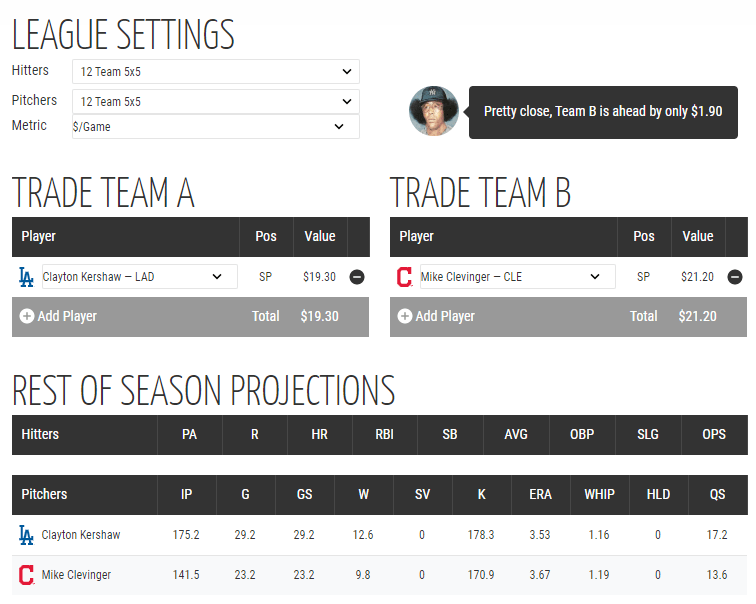Our fantasy baseball trade analyzer just got a little better as you can now evaluate trades based on players’ full/rest of season value ($) OR their per game value ($/Game).
The $/Game metric has been reported in our Player Raters (Preseason, Season to Date, Rest of Season) and Player Pages for several years now. I think it is one of our more underrated/underused metrics so I am going to use this post as a primer on its value.
What is the difference between $ and $/Game?
The standard way of valuing fantasy players is on projected stats for the full season (or rest of season once the season has started). We find auction $ value (based on $260 for all starting players with a 67/33 hit/pitch split) to be the most intuitive scale/metric for valuing players but other methods (e.g., summing z-scores) provide similar benefits.
The downside of full/rest of season projections for comparing players is they reflect both projected performance AND playing time. This is fine when comparing players with similar playing time projections but creates issues if playing time is uneven because one of the players is projected for less playing time because of injury, minor league time, unsettled role, etc. A full season value for a player with discounted playing time essentially treats all that missing time as a zero. We know for DL stints or minor league time that we can plug in a replacement and, thus, the full season stats will undervalue the player with discounted playing time.
The $/Game metric removes playing time from the equation so you can focus strictly on performance. Everything else equal, you want the player with more projected playing time. The $/Game lets you determine if truly ‘everything else is equal’ or if you are trading quality for quantity.
Here is an example. You did an early 2020 draft and are now frustrated to learn Mike Clevinger will start the season on the IL. A leaguemate swoops in and offers Clayton Kershaw. Through the lens of full season value ($), this is a great trade. Kershaw is worth about $6 more in 12-team mixed thanks largely to a 6 GS / 34 IP advantage.

But when viewed through $/Game, Mike Clevinger is worth about $2 more largely because of his higher K-rate. As long as you can backfill Clevinger’s April-early May with a decent arm, this is close to an even trade.

What types of players should be compared using $/Game?
The $/Game metric works best when making the following comparisons: Hitter(s) vs Hitter(s), Starting Pitcher(s) vs Starting Pitcher(s) and Relief Pitcher(s) vs Relief Pitcher(s). The reason for this is different playing time averages. An RP is less valuable than an SP on a per game basis but will pitch in 2x+ games. Hitters are playing 2-5x as much as a pitcher.
What is more imporant – winning a trade based on $ or winning it based on $/Game?
Ideally you are ahead on both. There is no fixed rule here but I have a slight preference for $/Game unless the playing time differences are significant.
How does this compare to projecting values where playing time is equal for all players – e.g., Steamer 600?
The $/Game metric neutralizes games started by hitters/SPs and games relieved by relievers. But, unlike a Steamer 600, $/Game maintains the projected PA/IP per game for players. A leadoff hitter is going to have more PA/Game than a 9th place hitter. A leadoff hitter on a great offense will get more PA/Game than a leadoff hitter on a bad offense. Max Scherzer is going to have higher IP per GS than Robbie Ray. Thus, the $/Game metric is superior to one based on a fixed PA/IP projection since it only neutralizes the relevant variable (games).
How does $/Game account for a hitter’s role – e.g., Cody Bellinger is going to play every day vs RHP and LHPs while Joc Pederson will largely only see RHPs?
Our full season/rest of season projections factor in a player’s projected RHP vs LHP splits. The $/Game metric found in the Trade Analyzer (and in the Player Raters) keeps that same split. If you are trying to value a platooned hitter in a full-time role, the best method is going to their player page which shows a $/Game metric vs RHP and LHP. You could weight it based on league-wide splits which are around 70% RHP and 30% LHP.
For pitchers projected with SP and RP innings, the $/Game metric in the Trade Analyzer (and Player Rater) reflects the role in the Pos field. Typically, most pitchers with any projected GS are treated as SPs.
Why don’t you create a $ that bakes in replacement cost for any missing games (e.g., give Clevinger his 23 GS and add 6 replacement GS)?
While this could be done, it assumes everything but max playing time can be backfilled with replacements. This is generally true for IL and minor league stints but harder to do for mid-week rest days and platoons. It is easier to plug in a replacements in daily roster change leagues vs weekly.
You can calculate your own hybrid $ calculation factoring in replacement – e.g., Clevinger’s 23.2 GS * $21.2 + 6 GS * $1 = $17.05.


